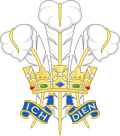| 9th/12th Royal Lancers (Prince of Wales's) | |
|---|---|
 Badge of the regiment | |
| Active | 11 September 1960 – 2 May 2015 |
| Allegiance | |
| Branch | |
| Type | Cavalry |
| Role | Formation Reconnaissance |
| Size | One regiment |
| Part of | Royal Armoured Corps |
| Garrison/HQ | RHQ: South Wigston, Leicester Regiment: Hohne, Germany |
| Nickname | The Delhi Spearmen [1] |
| Motto | Ich Dien (I Serve) |
| March | Quick: God Bless the Prince of Wales Slow: Men of Harlech , The Coburg March |
| Anniversaries | Mons/Moy |
| Commanders | |
| Colonel-in-Chief | Queen Elizabeth The Queen Mother (1960–2002) The Duke of York (2003–2015) |
| Colonel of the Regiment | Major-General J.H.T. Short CB OBE |
| Insignia | |
| Tactical Recognition Flash |  |
| Arm Badge |  from 12th Dragoons |
| Abbreviation | 9/12 L |
The 9th/12th Royal Lancers (Prince of Wales's) was a cavalry regiment of the British Army, formed in 1960 by the amalgamation of the 9th Queen's Royal Lancers and the 12th Royal Lancers. In the later years of its existence, the regiment served as a formation reconnaissance regiment, equipped with the Combat Vehicle Reconnaissance (Tracked) family of vehicles and was attached to the 7th Armoured Brigade, the Desert Rats. The regiment was based in South Wigston, Leicestershire, along with its affiliated Territorial Army unit, B (Leicestershire and Derbyshire Yeomanry) Squadron, The Royal Yeomanry. It was amalgamated with the Queen's Royal Lancers on 2 May 2015 to form the Royal Lancers

